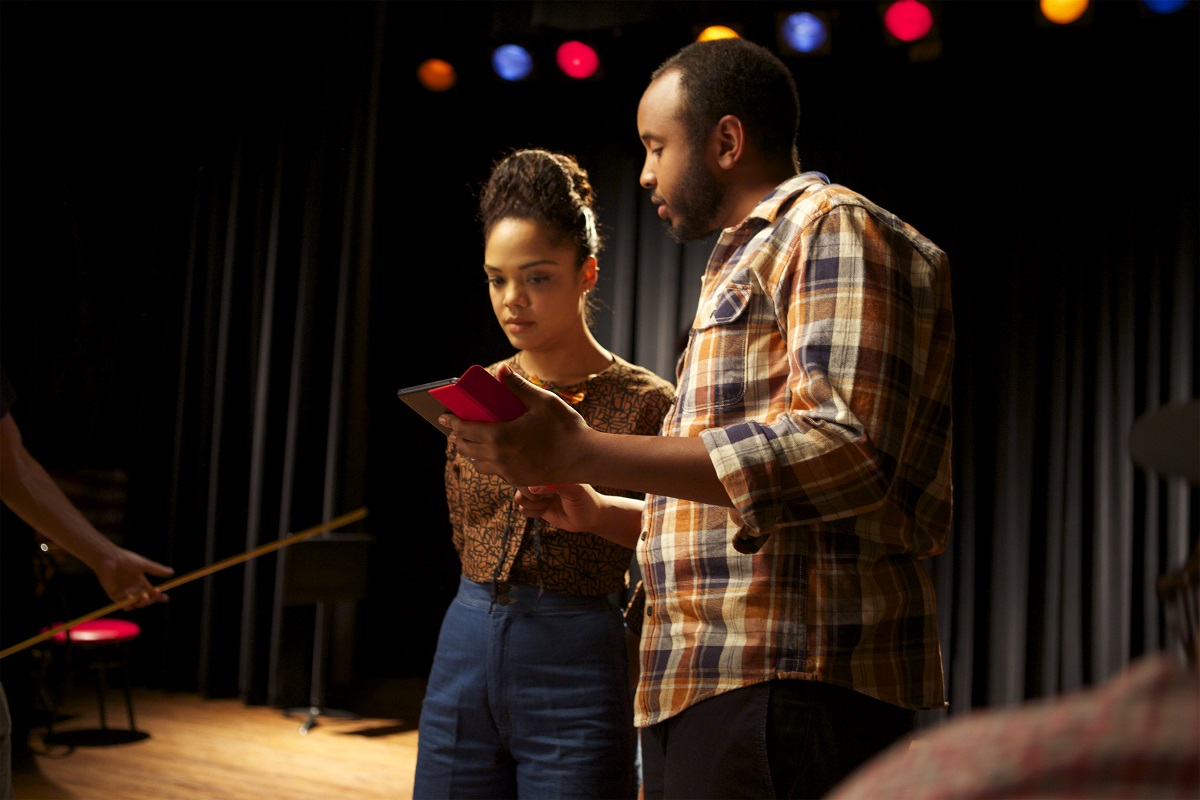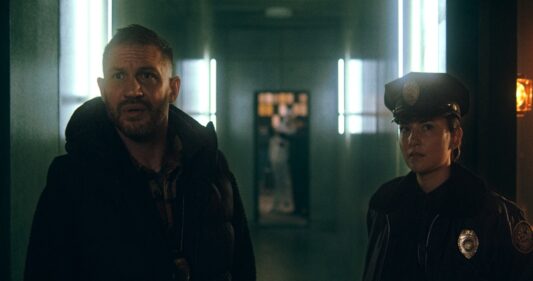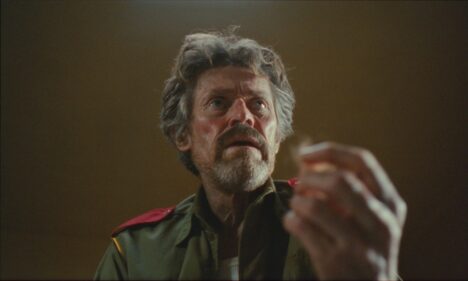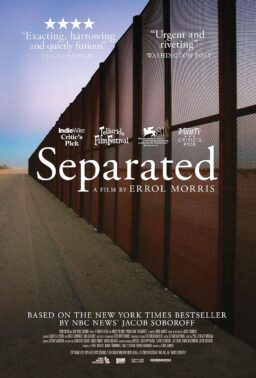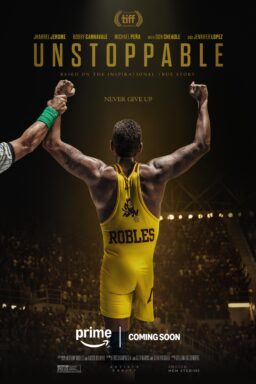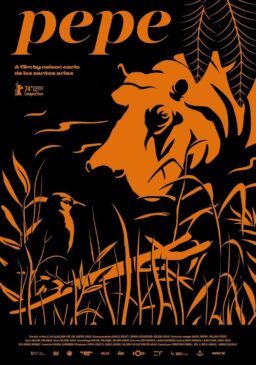“Dear
White People” is a film that follows a quartet of African-American college
students as they try to negotiate their seemingly different but ultimately
intertwined ways through the predominantly white campus of their Ivy League
university. Sam (Tessa Thompson) is the campus firebrand who has a radio show
entitled “Dear White People” in which she humorously calls out whites
for the unconscious behaviors that are almost as insulting as outright
racism. Troy
(Brandon P. Bell) is the far smoother and self-assured type whose seemingly
effortless rise to the top is stymied when he unexpectedly loses the election
for student leader of the school’s one predominantly black residence hall to
former girlfriend Sam. Coco (Teyonah Parris) is a fame-obsessed type who
attempts to position herself as an alternative campus voice in the hopes of
attracting the attentions of a reality show that is casting on campus. As for
budding journalist Lionel (Tyler James Williams), he is struggling to find
himself despite the double-outsider status of being both black and gay. Among
the Caucasian faces in the mix are Gabe (Justin Dobies), the genial RA who is
also Sam’s boyfriend, a fact that she is desperately trying to keep secret for
fear of how it will look to others and Kurt (Kyle Gallner), the obnoxious and
privileged campus alpha male who is the son of the university’s president and
the head of the school’s celebrated humor magazine that is preparing to throw
an “African-American” party that encourages white students to come as
their favorite stereotypes and which leads to a campus race riot. (If that last
detail seems a little too much, please note that the end credits for the film
include an array of startling photos taken at numerous real-life gatherings
along those lines that have occurred on campuses across the country over the
last few years.)
Wait, did
I neglect to mention that the film in question is also a comedy? Instead of
using the material in the service of an earnest, well-intentioned but
ultimately dull melodrama,
debut writer-director Justin Simien has instead taken an overtly satirical
approach that allows him to tackle the charged material in a way that allows
him to deal with some hard truths about the contemporary African-American
experience without getting bogged down in deadly dogma. The film is smart and insightful without becoming pedantic, and
contains a number of big laughs to boot. By putting his focus as much on the
notion of young people trying to discover who they are as individuals as on the
racial aspect, he tells a story that can appeal to a wider audience without
watering things down in the process. This is an ambitious and ultimately successful work and while it
may not quite be, as some of the early reviews have suggested, the next
“Do the Right Thing” (it is actually closer to Spike Lee‘s
ridiculously underrated 2000 satire “Bamboozled“), it is certainly
strong enough to justify “Variety” naming Simien as one of this
year’s 10 filmmakers to watch.
For
Simien, the release of the film, which opened in New York last Friday and will
be expanding throughout the country, marks the end of a long journey that began
when he first conceived of the project in 2012 and produced a fundraising
trailer that unexpectedly went viral and brought in over $40,000 and included a
triumphant premiere at this year’s Sundance Film Festival, where he won one of
the Special Jury Prizes. This week, while basking in the strong reviews and
box-office results of its opening weekend and preparing to introduce “Dear
White People” as part of the Chicago International Film Festival, Simien
sat down to discuss the issues raised by his movie, the decision to look at
them through a comedic perspective and the current state of black filmmaking.

Now that
“Dear White People” has finally arrived in theaters this past weekend
to strong reviews and box office, what has it been like for you to finally have
it out there for the public to see once and for all?
JUSTIN SIMIEN: I am
relieved. I guess that for the first time in the entire process, I was finally
able to exhale. There was always something coming up next that could go
horribly wrong and it has been like that for a long time. “What if no one
finances this?” “What if Sundance doesn’t accept it?” What if no
one picks it up out of Sundance?” “What if we don’t open well?”
Well, it finally came out and we opened well and I am good. I am happy that
critically the film is being well-received and that audiences are receiving it
well and are abuzz with questions and conversations. It is a big “Mission
Accomplished” and everything after this is like icing on the cake.
What inspired
the film and how closely is it inspired by your own collegiate experiences?
It came
out of that. The script changed a lot but it started with having several
conversations in college about our experiences as black people at a mostly
white college versus what was presumed to be our experiences. We all had
friends of all races and there were awkward moments and awkward conversations
and I just thought that it was a way to say something new about the experience
of being a person of color as well as a way to indulge in my love of black smarthouse
films that Spike Lee begat but which were also carried out by other filmmakers.
It was before my time but I love that there was a time when there were films
like “Hollywood Shuffle” and “Love Jones” and “Boyz N
the Hood”—all these different stories that were different from each other
and different versions of the experience that were all together in the
marketplace. I kind of wish that I had been a part of that in a way and it was
a way to throw back to that while saying something new.

What
governed your decision to approach the material from a more overtly satirical
perspective?
It was just
always funny to me. I think part of it is that when we were having these
conversations—before I considered it to be a satire or considered the school
to be a microcosm of the American experience—it was just my experiences on a
college campus and they were always funny. When we would tell these stories,
they were always hilarious and we laughed about it. To me, it always had a
humorous tone to it but as it went from the shitty first drafts that are
inevitable for most screenplays into something better and more powerful, I just
doubled-down on the decision that the best way to talk about it was
satirically. I had seen a lot of the earnest films that had dealt with race and
the more dogmatic and earnest that they were, the less they felt like real
life. They didn’t look like the real racism that I would see in America.
“Do the Right Thing” as a screenplay
might seem like a drama but he shot it almost like a comic book with a
heightened reality—yelling racial epithets directly into the camera—and it
would not have worked and the ending would not have been as powerful if you had
spent the entire time just being dragged through the mud. Frankly, if we are
going to talk about racial violence, “Fruitvale Station” and “12
Years a Slave” did that really well and I wanted to do something that
hadn’t been talked about or said. My focus was about identity–the issues of
identity and the ways in which identity can complicate our lives. I hadn’t seen
that in movies, at least not through the lens of being a person of color.
“Do the
Right Thing” has been cited a lot in commentary on “Dear White
People” but the Spike Lee film that it reminded me of even more was
“Bamboozled,” his satire on contemporary racial stereotypes that
bothered a lot of people when it came out in 2000 but which I still consider to
be one of the best and bravest of all his films.
I so
agree. It looked so unconventional that it was jarring to people but I loved
that movie. It literally makes me laugh and cry—I know that sounds like a
cliche but I am moved to tears by the end of that film. The mark of a really
great satire is its ability to seem prophetic and I think that the television
culture that film predicted really came true in the age of reality television
and is a testament to how great it really is.

You were just
speaking about how you wanted the film to focus on identity. Can you talk about
your approach to exploring questions of identity through your four central
characters and the different ways that the negotiate the experience of being
black on a mostly white college campus?
I thought
that the film was about identity versus self. I thought it would be interesting
to talk about something that I think is a human condition—that struggle
between who am I versus who people see me as—and talk about it through a black
lens because before I could ever ask the question “Who am I?,” I had
to get through the minutiae of who I am as a black person and who I am as a gay
person. I sort of had to answer the questions of identity that were thrust upon
me that I wasn’t innately asking until the world was asking.
I
remember the first time that I realized that being black meant that I wasn’t
allowed certain things. It was in the fourth grade and it was who I thought was my best friend
not inviting me to his birthday party because I would be the only black kid
there. It was the first time I ever felt restricted and it certainly wasn’t the
last time. I remember the shock of that—that I wasn’t having the same human
experience as the rest of the kids. I was somehow being held by this identity
that was created by somebody else about me. I just thought that was an
interesting way of talking about identity that I hadn’t seen before and it was
an opportunity to say something new about the subject. If the focus of the film
is on identity, then anyone can sort of find a way in even though it is through
these characters and their experiences.
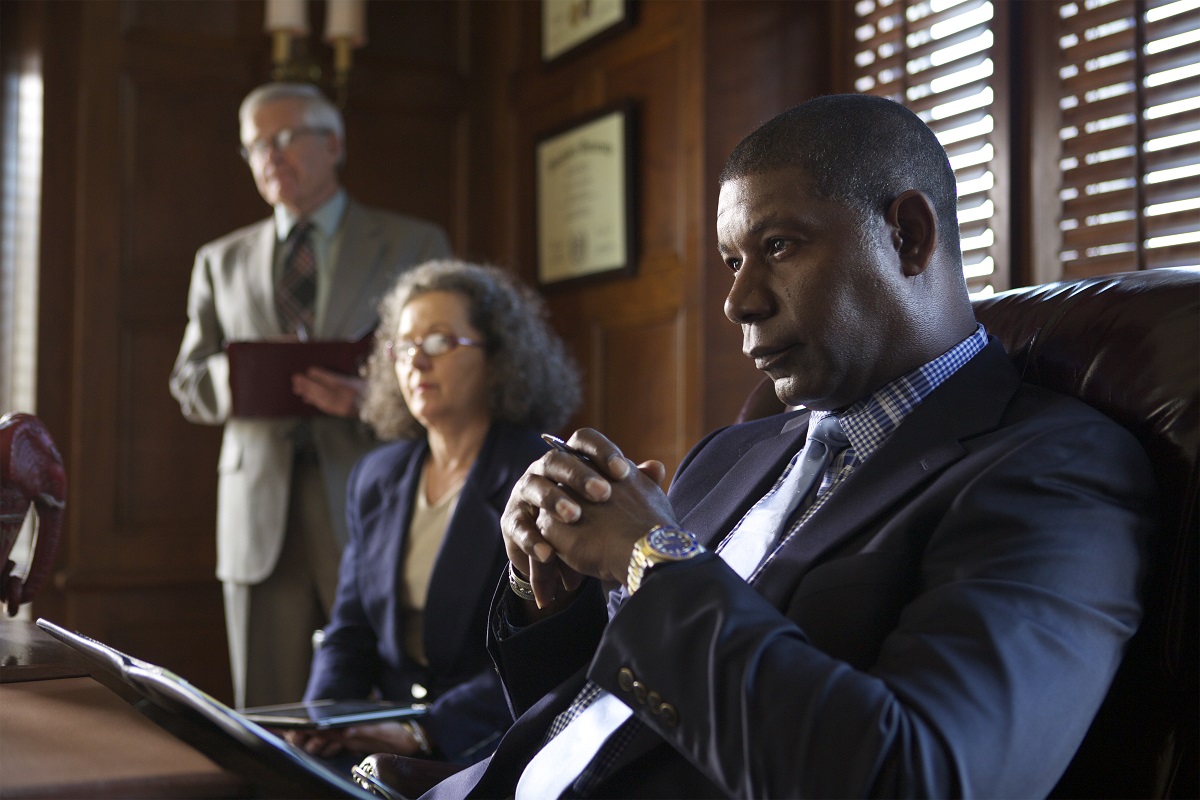
One of the
things that I found interesting about the way that racism is handled in the
film is that of the two major white characters, neither one is particularly
racist. Gabe, the RA and Sam’s clandestine boyfriend, is arguably the single nicest character in the film and Kurt, the alpha-male humor magazine
editor, is certainly a boor, but he comes across as an obnoxious equal-opportunity
offender who mistakenly sees himself as following in the footsteps of people
like Lenny Bruce or Richard Pryor who would say shocking things as a way of
getting at greater truths. Instead, the real racism in the film is embodied by
the institution of the school itself and its policies.
Well,
that is the way that racism actually works. Yes, there are people who are
outwardly racist and say outwardly racist things but more often than not, the
kind of racism that affects the daily lives of people is the institutionalized
racism, the kind that is baked in—the covert assumptions and the way in which
people are subtly left out of access to certain things. That is how is actually
works and functions and oftentimes, the conversation comes around to who is to
blame and that loses sight of what the real issue is, which is that it is baked
into the system. Kurt and even the president of the university, their sin isn’t
racism—it is a lack of tolerance for the experiences of people who are
different from them.
“Color-blind” comes up—people say
“Oh, I’m color-blind and therefore can’t be accused of racism,” but I think that
if we are going to have an honest dialogue about racism, we have to admit that
people of color are having a different experience. I have different privileges
because I am a man and I have to acknowledge that and realize that another
person of color who is also a woman is having a different experience than I am.
Just saying that black people are inferior, that is not what it looks like anymore.
What kind of
response have you received to the potentially controversial plot development
involving Sam’s secret romance with Gabe?
I have
noticed that some audience members have wondered if I am trying to say
something globally about black men and white men. I think a lot of that may be
that many movies that are about race are dogmatic and they tend to have very
clear-cut lessons for the audience to walk away with. I think that Sam’s dual
life when it comes to her guys—I think that is a real dilemma that a lot of
women face. The pressure of whether to pick who the people around me think I
should pick or should I pick who I secretly want even though it might be
inconvenient for my life and my persona. That is a real struggle and a real
thing and I know a lot of people who appreciate that the movie gets into that
and articulates that. I also get people who want to make sure that I am not
saying anything globally about interracial dating and I think part of that is
that films like this dealing with subject matter like this are rare and I think
part of it is that audiences have to get used to films that deal with racism in
ways that aren’t dogmatic or that isn’t a morality play.

When you are
discussing the film with audiences or looking at the reviews, have you found
that there is a difference in the elements that black commentators and white
commentators seem to be focusing upon?
I will be
honest—I don’t like to read every review because I am far too neurotic and I
don’t want to put myself through the nitpicking of every single review. I do
notice that with audiences, laughter does come in different spots and people
walk away with different things. I think that for African-American audiences
who have experienced in very specific and concrete ways the things that are
depicted in the film, I think there is an immediacy to it that is different
than it is for a white audience, for whom it is more theoretical. When we have
shown the movie on campuses, we get into very specific discussions about how to
work as student activists on campus and how to rally up against things that I
am not really qualified to give advice on. It is interesting to see audiences
take different things away.
How close is the
final version of “Dear White People” that is now playing to the
version that you saw in your head when you first envisioned it?
It
changed a lot. The first version of it was more Altmanesque—it was very
slice-of-life and while it was satirical, it wasn’t a satire. It followed 7 or
8 other characters and they were all very different—Sam, Troy, Lionel and Coco
were all there but there were these 7 or 8 other characters and they all had
equal weight and the script was incredibly long. It was meant to be this
year-in-the-life-of more so than building to a culminating event that affected
everybody. That was the big change over the years—it became more of a satire
and it became about something specific. For financial reasons, I felt that it
made more sense to focus on four characters—two sets of two opposites—and tell
the story in a sort of point-counterpoint way.
You spoke
earlier of wishing that you could have been making movies in the time of films
like “Do the Right Thing” and “Boyz N the Hood.” What are
your thoughts about the current state of black filmmaking?
I think
we are still in that kind of dichotomy where there are either awards-time
movies where you see a black youth slain or a slave or some disenfranchised
black person in a tragedy or the springtime romantic comedies for general
audiences like “Think Like a Man” or even something like “No
Good Deed”—a proven genre film that never really gets into anything
complicated. One is for the box office and the other is for awards season but the
arthouse stuff—the stuff that tries to talk about the human condition and
which try to say something important about us now—you rarely see people of
color in those kinds of movies. That is just where my interest lies more than
in the others—those core-driven movies that are meant to be about something
and where people of color are seen as human beings because they are not these
tragic characters or these aspirational types trying to live up to this
superhuman ideal of being black, this “Ebony”-cover version of being black. There is a real power in
putting the truthful, complicated and messy versions of us and I would like to
see more of that.

